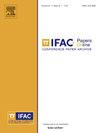电机损耗的紧致代数模型
Q3 Engineering
引用次数: 0
摘要
在设计电力驱动系统和开发电力动力系统节能控制策略时,仿真得到了广泛的应用。仿真结果的准确性取决于模型的准确性以及它如何很好地描述系统中的损耗。开发了一种新的电机损耗模型,其思想是将其划分为一组描述导致电机损耗的元素的方程。对于用一组方程表示的机器模型,可以利用该模型进行数值最优控制,并利用这些方程建立有效的求解方法。当软件工具可以使用算法微分来计算和使用梯度和Hessians来区分模型,同时搜索最优控制轨迹时,这一点尤其有趣。首先以一台电机为基础建立了电机损耗模型,然后在另外三台电机上对模型进行了评估。该模型在参数上是非线性的,针对所提出的模型结构,提出了一种有效的数值参数整定方法。本文章由计算机程序翻译,如有差异,请以英文原文为准。
A compact algebraic model for electric machine losses⁎
Simulations are used extensively while designing electric drive systems and developing energy-efficient control strategies for electric powertrains. The accuracy of the simulation results depend on the accuracy of the model and how well it describes losses in the system. A new model for electric machine losses is developed, where the idea is to divide it into a set of equations describing the elements that contribute to the machine losses. With a machine model expressed using a set of equations it is possible use the model for numerical optimal control that can utilize the equations to develop effective solution methods. This is especially interesting, when software tools can differentiate the model using algorithmic differentiation to compute and use gradients and Hessians while searching for the optimal control trajectories. The model for electric machine losses was developed using one machine as basis and then the model was evaluated on three other machines. The model is nonlinear in the parameters and an efficient numerical parameter tuning method is developed for the proposed model structure.
求助全文
通过发布文献求助,成功后即可免费获取论文全文。
去求助
来源期刊

IFAC-PapersOnLine
Engineering-Control and Systems Engineering
CiteScore
1.70
自引率
0.00%
发文量
1122
期刊介绍:
All papers from IFAC meetings are published, in partnership with Elsevier, the IFAC Publisher, in theIFAC-PapersOnLine proceedings series hosted at the ScienceDirect web service. This series includes papers previously published in the IFAC website.The main features of the IFAC-PapersOnLine series are: -Online archive including papers from IFAC Symposia, Congresses, Conferences, and most Workshops. -All papers accepted at the meeting are published in PDF format - searchable and citable. -All papers published on the web site can be cited using the IFAC PapersOnLine ISSN and the individual paper DOI (Digital Object Identifier). The site is Open Access in nature - no charge is made to individuals for reading or downloading. Copyright of all papers belongs to IFAC and must be referenced if derivative journal papers are produced from the conference papers. All papers published in IFAC-PapersOnLine have undergone a peer review selection process according to the IFAC rules.
 求助内容:
求助内容: 应助结果提醒方式:
应助结果提醒方式:


